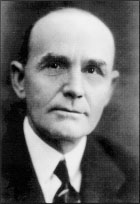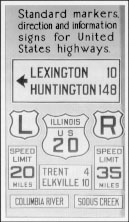November 18
| 1925 | Secretary of Agriculture W. M. Jardine approves the Joint Board on Interstate Highways' plan for U.S. numbered highways and uniform signing. The Joint Board had originally identified 55,137 miles for inclusion, at which point, in the words of AASHO president and Joint Board member Frank Rogers of Michigan, "the Infernal regions began popping," as communities began lobbying for their route. The Secretary submits the plan, which now includes 75,884 miles, to AASHO to "take the necessary steps as might be feasible under their respective State laws to put the plan into operation." Under pressure from the "infernal regions," AASHO expands the U.S. system to 96,626 miles before approving the proposal on November 11, 1926.
| |||
| 1938 | While attending AAA's Annual Convention in Cleveland, OH, Chief Thomas MacDonald is interviewed for a 1:45 p.m. radio broadcast over NBC's Blue Network. Introduced by AAA President Thomas P. Henry as "an outstanding authority on highway development and highway trends," MacDonald discusses the road inventory surveys underway, noting that the information gathered will help the country adjust present roads to modern traffic conditions.
"From now on, in all our new road building we must try to look ahead at least to 1960 . . . we must try to anticipate the volume and other conditions of the 1960 traffic and make ample provision to meet those conditions in our present planning." | |||
| 1957 | During AASHO's Annual Meeting, BPR's Herbert S. Fairbank becomes the first recipient of the Thomas H. MacDonald Award for outstanding contributions to highway progress. U.S. Representative George Fallon, Chairman, Subcommittee on Roads, House Committee on Public Works, addresses AASHO the same day: "I think I hear practically all of the complaints that you officials live with all the time. There are those who claim the program is bogging down and want it speeded up and those who in cities would like to declare a moratorium for two or three years to provide time for urban planning; those who insist on a community bypass and those who resist the bypass; those who can never agree with those who consider the interstate ugly or 'phony' as
to defense importance; those who see opportunity in doing strange and wondrous things with the Trust Fund money . . . . [Those are] some of the typical complaints and charges that I hear; actually the immensity of the program and its long-term benefits have not yet really come home to the public."
"Actually the immensity of the program and its long-term benefits have not yet really come home to the public." | |||
| 1977 | For the first time in BPR/FHWA history, former Federal Highway Administrators meet with the current Administrator in an open house. Former Administrators John Volpe, Norbert Tiemann, Frank Turner, Lowell Bridwell, and Bertram Tallamy join Administrator William Cox. Commissioner "Cap" Curtiss and Administrator Rex Whitton, the other two surviving Administrators, are unable to attend. | |||
| 2008 | President George W. Bush visits DOT headquarters, the first time a President had visited DOT headquarters since President Ronald Reagan (see January 12, 1982). Speaking in the East Atrium, President Bush thanks Secretary of Transportation Mary E. Peters for her work following the collapse of the I-35W bridge in Minneapolis, MN (see August 1, 2007). "The Secretary coordinated a swift and an effective Federal response." His primary purpose is to announce new regulations to protect air travelers. |



